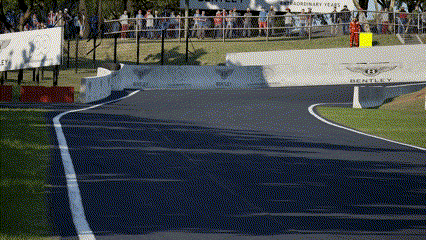Death of the V12
A look back at the iconic 12 cylinder engine
Cover Image: McLaren F1 GTR @ Silverstone
Death of the V12
A look back at the iconic 12 cylinder engine
Cover Image: McLaren F1 GTR @ Silverstone
The V10 engine gets a lot of love online, it even has its own podcast. Whether it's a screaming F1 engine from the late 90s/early 2000s or a literal truck engine in the Dodge Viper, people mourn the lack of V10s currently being used in the world. Only Audi/Lamborghini still produce cars with 10 cylinders and those are not long for this world. However, there is another engine facing its final days, one that has had a far more significant role in motoring history.
If I were to say the name “Ferrari” to you, what instantly
comes to mind? Schumacher, the colour Red, killer strategy… There’s something else
that comes to mind, something that hasn’t been used by Ferrari, in racing at
least, for decades. If you can’t guess, then have a listen (listen anyway).
It’s the V12. The V12, or 12 cylinders in some form, was the staple of early
Ferrari success (sometimes even supercharged!). Enzo was such a believer that
anything less than 12 cylinders was not considered a proper Ferrari (see Dino).
As time went on however, even someone as set in their ways as "il
Commendatore" would be forced to adapt. While Ferrari V12’s were among the
most powerful engines in Formula 1 and sportscar racing, technical developments
would decrease their effectiveness. Ground effect desired a smaller, narrower engine design such as the Cosworth DFV, and the advancement in turbocharging
from Renault and Porsche would allow for massive increases in horsepower that
an N/A car simply could not keep up with. Whilst they would receive a reprieve
in the early 90’s, Ferrari would eventually join the rest of the F1 grid in
switching to a V10 for 1996, with Jean Alesi taking the final win for a 12
cylinder car at the 1995 Canadian Grand Prix (Although McLaren would win the
last championship for a V12 with Honda in 1991). The Ferrari V12 would survive a little
longer in customer programs such as the 333SP and 550/575 GT cars, but these
too would be gone by the middle of the 2000s.
While Ferrari V12s are closely associated with the early
days of the team, under direct leadership of the man himself, the V12 arguably
had its heyday at the end of the 20th century. Between the mid-90s and
early 2010s, Le Mans would become the home of the V12. Lamborghini, Aston
Martin, Jaguar/Lister, McLaren, BMW, Mercedes (in the WEC, not at LM) and
Maserati would all run 12-cylinder cars at the great race. Audi and Peugeot
would even run diesel powered V12s. For a race all about efficiency, there was
an unusually high turnout of heavy, thirsty engines.

Alas, the thunderous sound of a dozen 12-cylinder monsters
pounding round the French scenery couldn’t last. Audi switched to a V6 hybrid,
Ferrari and Aston Martins GTs switched to V8s and the rest pulled out. The last
factory V12 race car was the Aston Martin Vantage GT3 which saw its last
top-line event in the 2019 Bathurst 12 hours and like all old school heroes it
refused to go out quietly. Despite losing pole to a technical infringement it
still led into the last hour, with a late safety car playing to the advantage of
the EMB Motorsport Porsche.

The V12 continues to live on in road cars, but even here,
their days are numbered. Ever tightening emission restrictions are making it
difficult for such large engines to be approved. Those that survive are now
turbocharged or will be hybridised. When it comes to pure power, an assisted
smaller engine can produce similar power with greater economy, less weight and
better packaging. Even the V12s other distinctive feature, its refinement and smoothness of power
delivery, is no longer relevant with the rise of electric cars and their
instant, continuous deployment. What was once seen as a sign of power and sophistication will soon be no more.

And so, as a send-off to the V12, I’ve gathered what some of the most stand out examples of the breed. A digital assortment of sound and style to what used to be.
1) Ferrari 250 GT Lusso
NOT the GTO. Contrary to popular belief, the 250 existed in various forms, even a mid-engine LM version. But it’s the regular GT Lusso that I think is the best. A beautiful, hand-crafted Italian body with a sonorous, yet small capacity, V12 up front, where it belongs. To me, this represents the Ferrari, a high revving normally aspirated front engine GT. How it should be.

Ferrari 250 GT Lusso (MBNA) @ Trento Bondone
2) Aston Martin V12
Now under Ford ownership it was decided that Aston Martin needed a new, flagship engine, something other than a reheated Jaguar engine. Contrary to popular belief, the AML V12 was not two Ford V6s welded together, although some parts were shared. More importantly, from the beginning, the engine was designed with racing in mind. As a result, we were treated to the ear-bursting screams of Aston Martins competing in the worlds greatest endurance races for over a decade.
Lola B08/60 @ Monza
3) Mclaren Mp4/6
The car that provided Ayrton Senna his 3rd and final title. It was also the last (and technically only) car to win a championship with a V12 (and a h-pattern gearbox). The rumour is that the reason Honda switched from a V10 to the V12 was to dispel the argument that you couldn't win with a V12, as Ferrari was struggling to do. So, was this car just a middle finger to team red? Just makes the car even cooler in my opinion.
4) Audi R10
5) Jaguar V12
This one is a bit of a cheat as this is more of a series of cars powered by the same engine. Starting in the early 1980s, Jaguar made a return to racing in the new Group A touring car class. the car of choice would be a 5.3l V12 XJS. At the hands of Tom Walkenshaw and his eponymous team, they would clain the 1984 ETCC drivers championship. The car that was seen as the dissapointing follow-up to the E-type was now a champion.
TWR would then be given the contract to run Jaguars Le Mans program. Utilising the same basic engine, the XJR series of cars would slowly build up to challenging the Porsche 962. In 1987, with a now 7.0l engine, Jaguar would win the World Sportscar Championship, a feat they repeat the following year. This time they would also claim the coveted 24hrs of Le Mans for the first time since the 50s. Another Le Mans title would follow in 1990 before the V12 would be phased out of use, by choice and by regulation. But that is not the end of this engines racing life.
A small Jaguar tuner called Lister would decide to tackle the new BPR Global championship for GT cars. For this they would need a GT car, and being familiar with Jaguar products, decided that the natural choice would be the 7.0l from the group C car. As a result Lister would have the fastest four seater production car of the time. To clarify, a four seater road car with a genuine Le Mans winning Group C engine.
Thats why I love this series of cars. They could have used smaller turbo charged engines, or tried their hand at active susupension like those beginning to appear in F1 at the time. But no, they chose the biggest engine they could and went for it. These cars have a character that others can only dream of, and that'll do for me
